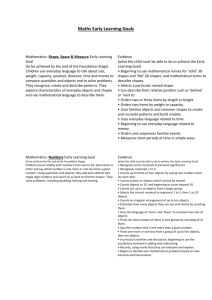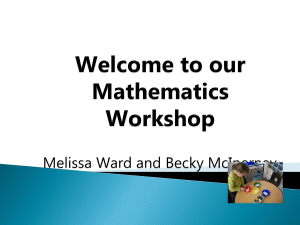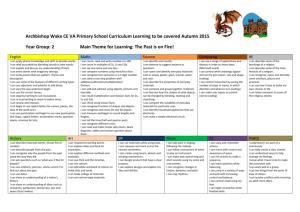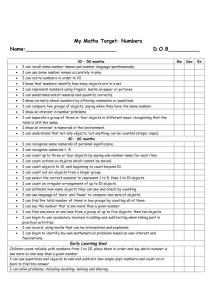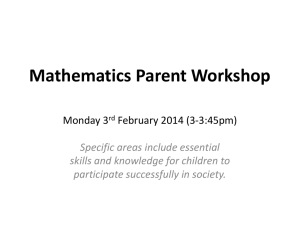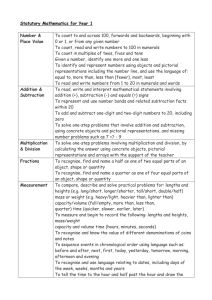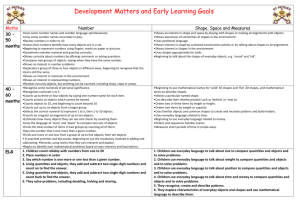Initial profile pages 3 & 4
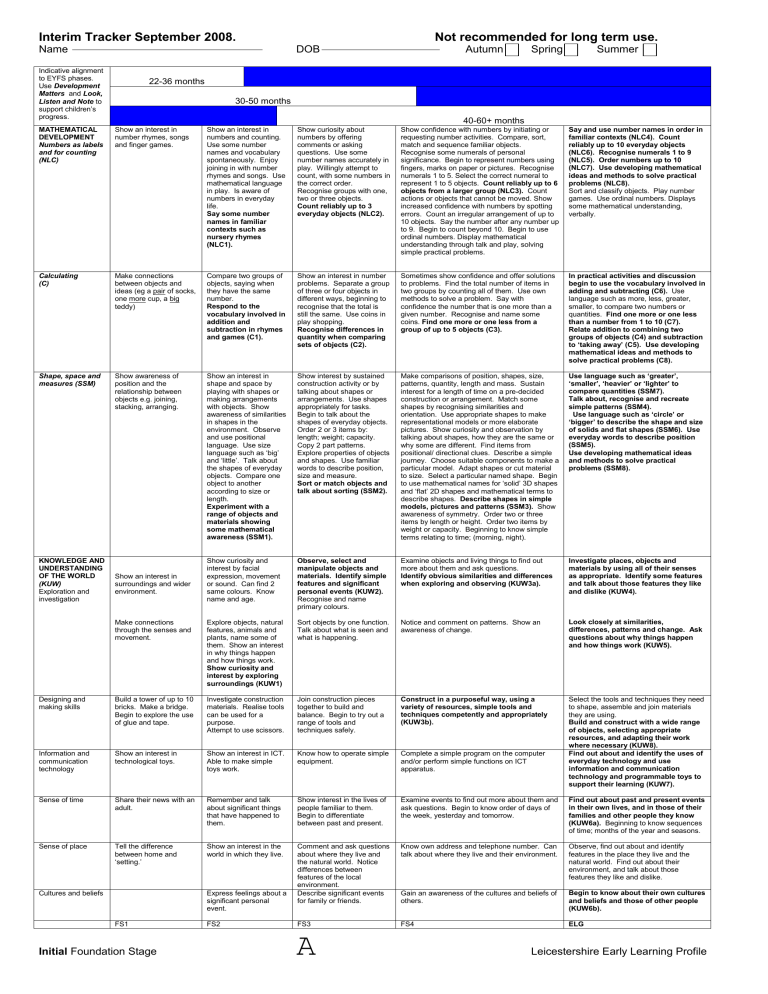
Interim Tracker September 2008. Not recommended for long term use.
22-36 months
30-50 months
DOB Autumn Spring Summer Name
Indicative alignment to EYFS phases.
Use Development
Matters and Look,
Listen and Note to support children’s progress.
MATHEMATICAL
DEVELOPMENT
Numbers as labels and for counting
(NLC)
Calculating
(C)
Shape, space and measures (SSM)
KNOWLEDGE AND
UNDERSTANDING
OF THE WORLD
(KUW)
Exploration and investigation
Show an interest in number rhymes, songs and finger games.
Make connections between objects and ideas (eg a pair of socks, one more cup, a big teddy)
Show awareness of position and the relationship between objects e.g. joining, stacking, arranging.
Show an interest in surroundings and wider environment.
Make connections through the senses and movement.
Show an interest in numbers and counting.
Use some number names and vocabulary spontaneously. Enjoy joining in with number rhymes and songs. Use mathematical language in play. Is aware of numbers in everyday life.
Say some number names in familiar contexts such as nursery rhymes
(NLC1).
Compare two groups of objects, saying when they have the same number.
Respond to the vocabulary involved in addition and subtraction in rhymes and games (C1).
Show an interest in shape and space by playing with shapes or making arrangements with objects. Show awareness of similarities in shapes in the environment. Observe and use positional language. Use size language such as ‘big’ and ‘little’. Talk about the shapes of everyday objects. Compare one object to another according to size or length.
Experiment with a range of objects and materials showing some mathematical awareness (SSM1).
Show curiosity and interest by facial expression, movement or sound. Can find 2 same colours. Know name and age.
Explore objects, natural features, animals and plants, name some of them. Show an interest in why things happen and how things work.
Show curiosity and interest by exploring surroundings (KUW1)
Investigate construction materials. Realise tools can be used for a purpose.
Attempt to use scissors.
Show curiosity about numbers by offering comments or asking questions. Use some number names accurately in play. Willingly attempt to count, with some numbers in the correct order.
Recognise groups with one, two or three objects.
Count reliably up to 3 everyday objects (NLC2).
Show an interest in number problems. Separate a group of three or four objects in different ways, beginning to recognise that the total is still the same. Use coins in play shopping.
Recognise differences in quantity when comparing sets of objects (C2).
Show interest by sustained construction activity or by talking about shapes or arrangements. Use shapes appropriately for tasks.
Begin to talk about the shapes of everyday objects.
Order 2 or 3 items by: length; weight; capacity.
Copy 2 part patterns.
Explore properties of objects and shapes. Use familiar words to describe position, size and measure.
Sort or match objects and talk about sorting (SSM2).
Observe, select and manipulate objects and materials. Identify simple features and significant personal events (KUW2).
Recognise and name primary colours.
Sort objects by one function.
Talk about what is seen and what is happening.
40-60+ months
Show confidence with numbers by initiating or requesting number activities. Compare, sort, match and sequence familiar objects.
Recognise some numerals of personal significance. Begin to represent numbers using fingers, marks on paper or pictures. Recognise numerals 1 to 5. Select the correct numeral to represent 1 to 5 objects. Count reliably up to 6 objects from a larger group (NLC3).
Count actions or objects that cannot be moved. Show increased confidence with numbers by spotting errors. Count an irregular arrangement of up to
10 objects. Say the number after any number up to 9. Begin to count beyond 10. Begin to use ordinal numbers. Display mathematical understanding through talk and play, solving simple practical problems.
Sometimes show confidence and offer solutions to problems. Find the total number of items in two groups by counting all of them. Use own methods to solve a problem. Say with confidence the number that is one more than a given number. Recognise and name some coins. Find one more or one less from a group of up to 5 objects (C3).
Make comparisons of position, shapes, size, patterns, quantity, length and mass. Sustain interest for a length of time on a pre-decided construction or arrangement. Match some shapes by recognising similarities and orientation. Use appropriate shapes to make representational models or more elaborate pictures. Show curiosity and observation by talking about shapes, how they are the same or why some are different. Find items from positional/ directional clues. Describe a simple journey. Choose suitable components to make a particular model. Adapt shapes or cut material to size. Select a particular named shape. Begin to use mathematical names for ‘solid’ 3D shapes and ‘flat’ 2D shapes and mathematical terms to describe shapes. Describe shapes in simple models, pictures and patterns (SSM3). Show awareness of symmetry. Order two or three items by length or height. Order two items by weight or capacity. Beginning to know simple terms relating to time; (morning, night).
Examine objects and living things to find out more about them and ask questions.
Identify obvious similarities and differences when exploring and observing (KUW3a).
Notice and comment on patterns. Show an awareness of change.
Say and use number names in order in familiar contexts (NLC4). Count reliably up to 10 everyday objects
(NLC6). Recognise numerals 1 to 9
(NLC5). Order numbers up to 10
(NLC7). Use developing mathematical ideas and methods to solve practical problems (NLC8).
Sort and classify objects. Play number games. Use ordinal numbers. Displays some mathematical understanding, verbally.
In practical activities and discussion begin to use the vocabulary involved in adding and subtracting (C6).
Use language such as more, less, greater, smaller, to compare two numbers or quantities. Find one more or one less than a number from 1 to 10 (C7).
Relate addition to combining two groups of objects (C4) and subtraction to ‘taking away’ (C5). Use developing mathematical ideas and methods to solve practical problems (C8).
Use language such as ‘greater’,
‘smaller’, ‘heavier’ or ‘lighter’ to compare quantities (SSM7).
Talk about, recognise and recreate simple patterns (SSM4).
Use language such as ‘circle’ or
‘bigger’ to describe the shape and size of solids and flat shapes (SSM6). Use everyday words to describe position
(SSM5).
Use developing mathematical ideas and methods to solve practical problems (SSM8).
Investigate places, objects and materials by using all of their senses as appropriate. Identify some features and talk about those features they like and dislike (KUW4).
Look closely at similarities, differences, patterns and change. Ask questions about why things happen and how things work (KUW5).
Designing and making skills
Information and communication technology
Sense of time
Build a tower of up to 10 bricks. Make a bridge.
Begin to explore the use of glue and tape.
Show an interest in technological toys.
Share their news with an adult.
Show an interest in ICT.
Able to make simple toys work.
Remember and talk about significant things that have happened to them.
Join construction pieces together to build and balance. Begin to try out a range of tools and techniques safely.
Know how to operate simple equipment.
Show interest in the lives of people familiar to them.
Begin to differentiate between past and present.
Construct in a purposeful way, using a variety of resources, simple tools and techniques competently and appropriately
(KUW3b).
Complete a simple program on the computer and/or perform simple functions on ICT apparatus.
Examine events to find out more about them and ask questions. Begin to know order of days of the week, yesterday and tomorrow.
Select the tools and techniques they need to shape, assemble and join materials they are using.
Build and construct with a wide range of objects, selecting appropriate resources, and adapting their work where necessary (KUW8).
Find out about and identify the uses of everyday technology and use information and communication technology and programmable toys to support their learning (KUW7).
Find out about past and present events in their own lives, and in those of their families and other people they know
(KUW6a). Beginning to know sequences of time; months of the year and seasons.
Sense of place Tell the difference between home and
‘setting.’
Show an interest in the world in which they live.
Comment and ask questions about where they live and the natural world. Notice differences between features of the local environment.
Know own address and telephone number. Can talk about where they live and their environment.
Observe, find out about and identify features in the place they live and the natural world. Find out about their environment, and talk about those features they like and dislike.
Express feelings about a significant personal event.
Describe significant events for family or friends.
Gain an awareness of the cultures and beliefs of others.
Cultures and beliefs
FS1 FS2 FS3 FS4
Initial Foundation Stage
A
Begin to know about their own cultures and beliefs and those of other people
(KUW6b).
ELG
Leicestershire Early Learning Profile
PHYSICAL
DEVELOPMENT
(PD)
Movement
Interim Tracker September 2008. Not recommended for long term use.
Name
Indicative alignment to EYFS phases.
Use Development
Matters and Look
,Listen and Note to support children’s progress.
22-36 months
Move spontaneously in space.
Respond to rhythm, music & story. Create intended movements
30-50 months
Move spontaneously within available space showing some control and co-ordination
(PD1).
Respond to rhythm, music and story by means of gesture and movement. Can stop with control.
Manage body to create intended movements.
Combine and repeat a range of movements. Developing control over mark making, construction and small world activities.
DOB
Move freely with pleasure and confidence, in a range of ways, showing some awareness of space
(PD2) , (such as slithering, shuffling, rolling, crawling, walking, running, jumping, skipping, sliding and hopping).
Use movement to express feelings.
Adjust speed or change direction to avoid obstacles. Negotiate space successfully when playing racing and chasing games with other children.
Sit up, stand up and balance on various parts of the body. Demonstrate the control necessary to hold a shape or fixed position. Mount stairs, steps or climbing equipment using alternate feet.
Increasing skill with activities requiring hand/eye co-ordination.
Autumn Spring
40-60+ months
Go backwards and sideways as well as forwards. Experiment with different ways of moving. Initiate new combinations of movement and gesture in order to express and respond to feelings, ideas and experiences. Jump off an object and land appropriately. Control speed and direction of movement in shared space.
Usually show appropriate control in large and small scale movements
(PD3).
Manipulate materials and objects by picking up, releasing, arranging, threading and posting them. Show increasing control over clothing and fastenings.
Summer
Sense of space
Health and bodily awareness
Using equipment
Using tools and materials
CREATIVE
DEVELOPMENT
(CD)
Exploring media and materials
Music
Imagination
Responding to experiences, and expressing and communicating ideas.
Begin to negotiate an appropriate pathway.
Discover and learn about their body.
Are active.
Climb stairs.
Attempt climbing a variety of equipment.
Manipulate toys and tools
Join in with simple exploratory activities.
Enjoy songs, ring games & stories.
Imitate mirror and react.
Pretend play with gestures and actions feelings and relationships, ideas and words.
Show an interest in what they see, hear, smell & touch.
FS1
Negotiate an appropriate pathway when walking, running or using a wheelchair or other mobility aids, both indoors and outdoors. Judge body space in relation to spaces available when fitting into confined spaces or negotiating holes and boundaries.
Show awareness of own needs with regard to eating, sleeping and hygiene. Often need adult support to meet those needs.
Operate equipment by means of pushing and pulling movements.
Engage in activities requiring hand-eye co-ordination. Use one-handed tools and equipment.
Begin to differentiate colours.
Use their bodies to explore texture and space. Make threedimensional structures. Explore using a range of senses. Use colour and line to represent.
Explore different media and respond to a variety of sensory experiences (CD1a).
Join in favourite songs.
Show an interest in the way musical instruments sound.
Respond to sound with body
Movement. Enjoy joining in with dancing and ring games.
Begin to move rhythmically.
Pretend that one object represents another, especially when objects have characteristics in common.
Notice what adults do, imitating what is observed and then doing it spontaneously when the adult is not there.
Engage in representational play (CD1b).
Sequence actions to enact observed behaviours.
Show an interest in what they see, hear, smell, touch and feel.
Use body language, gestures, facial expression or words to indicate personal satisfaction or frustration.
FS2
Show respect for other children’s personal space when playing among them.
Persevere in repeating some actions/attempts when developing a new skill. Collaborate in devising and sharing tasks, including those which involve accepting rules.
Show awareness of a range of healthy practices with regard to eating, sleeping and hygiene. Observe the effects of activity on their bodies.
Construct with large materials such as cartons, long lengths of fabric and planks.
Show increasing control in using equipment for climbing, scrambling, sliding and swinging.
Demonstrate increasing skill and control in the use of mark making implements, blocks, construction sets and ‘small world’ activities. Understand that equipment and tools have to be used safely.
Differentiate marks and movements on paper. Begin to describe the texture of things. Use lines to enclose a space, then begin to use these shapes to represent objects. Begin to construct, stacking blocks vertically and horizontally, making enclosures and creating spaces. Use a widening range of materials and equipment to explore and experiment.
Interested in mixing colours and using textures.
Sing a few simple, familiar songs. Sing to themselves and make up simple songs.
Tap out simple repeated rhythms and make some up.
Explore and learn how sounds can be changed. Imitate and create movement in response to music. Engages in music making (CD2a)
Use one object to represent another, even when the objects have few characteristics in common.
Use available resources to create props to support role play. Develop a repertoire of actions by putting a sequence of movements together. Enjoy stories based on themselves and people and places they know well. Engage in imaginative and role play based on own first-hand experiences.
Further explore an experience using a range of senses. Describe experiences and past actions, using a widening range of materials. Create simple representations of events, people and objects (CD2b).
FS3
Move body position as necessary. Show a clear and consistent preference for the left or right hand.
.
Show some understanding that good practices with regard to exercise, eating, sleeping and hygiene can contribute to good health.
Use increasing control over an object by touching, pushing, patting, throwing, catching or kicking it. Retrieve, collect and catch objects.
Explore malleable materials by patting, stroking, poking, squeezing, pinching and twisting. Manipulate materials to achieve a planned effect. Use simple tools to effect changes to the materials. Show understanding of how to transport and store equipment safely. Practise some appropriate safety measures without direct supervision.
Explore what happens when they mix colours. Understand that different media can be combined. Make constructions, collages, paintings, drawings and dances.
Use ideas involving fitting, overlapping, in, out, enclosure, grids and sun-like shapes.
Choose particular colours to use for a purpose. Experiment to create different textures. Work creatively on a large or small scale.
Begin to build a repertoire of songs.
Explore the different sounds of instruments. Copy simple repeated rhythms and make some up. Understand that instruments make sounds in different ways. Initiate and create movement in response to music.
Introduce a story line or narrative into their play. Play alongside other children who are engaged in the same theme. Play cooperatively as part of a group to act out a narrative.
Try to capture experiences using a variety of different materials CD3)
Respond with music, dance, paint and other materials or words.
Develop preferences for forms of expression. Talk about personal intentions, describing what they were trying to do. Respond to comments and questions, entering into dialogue about their creations. Make comparisons.
FS4
Move with confidence, imagination and in safety
(PD4a).
Can work co-operatively with partner.
Use small and large equipment, showing a range basic skills
(PD6).
Move with control and coordination. Travel around, under, over and through balancing and climbing equipment . Show awareness of space, of self and others (PD4b).
Show awareness of space, of themselves and of others.
Recognise the importance of keeping healthy and those things, which contribute to this.
Recognise the changes that happen to their bodies when they are active (PD8).
Use a range of small and large equipment.
Demonstrate fine motor control and co-ordination (PD5).
Handle tools, objects, construction and malleable materials safely and with basic increasing control (PD7).
Explore colour, texture, shape, form and space in two or three dimensions (CD5).
Sing simple songs from memory (CD4)).
Recognise and explore how sounds can be changed.
Recognise repeated sounds and sound patterns and match movements to music (CD6).
Use their imagination in art and design, music, dance, imaginative and role play and stories (CD7a).
Respond in a variety of ways to what they see, hear, smell, touch and feel (CD7b). Express and communicate their ideas, thoughts and feelings by using a widening range of materials, suitable tools, imaginative and role play, movement, designing and making, and a variety of songs and musical instruments
(CD8).
ELG
Initial Foundation Stage
A
